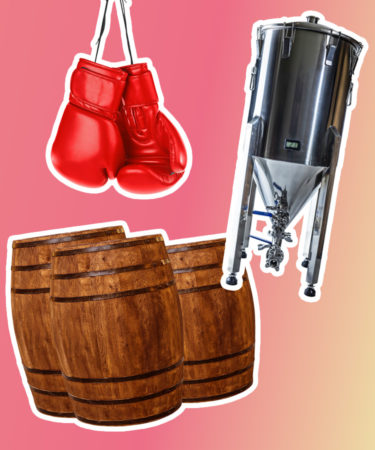
Tart, tangy, and technically contaminated, kettle sours are an increasingly popular craft beer category. But the term “kettle sour” is not a beer style; rather, it’s a means to an end.
Kettle souring, also called quick souring, is a production method that gives us beer styles like gose and Berliner weisse, along with what we like to call Warhead beers — the quick-soured puckerers that tend to be as bright in color as they are in acidity.
“Kettle” refers to the brew kettle, meaning the beer is soured in a stainless steel mash tun and fermented in a similar tank. This denotes the key difference between kettle sours and traditional sours: steel over barrel.
Souring in a steel “kettle” is faster and easier than the traditional sour beer method. The latter often involves aging in wood with a mix of microbes, and, most of all, time. Traditional sours can take several months or even years to create, while a kettle sour can be turned around in a matter of days. It’s a great way for busy brewers to get their tart on.
Producing Pucker
The magic ingredient that turns an ordinary mash into a sour mash? Lactobacillus.
Also called “lacto,” this bacteria is a probiotic that converts sugars to lactic acid. It’s the same live culture you’ll find in unsweetened yogurt and sauerkraut.
“They’re infinitely drinkable,” Jason Ebel, owner of Two Brothers Artisan Brewing, told the Chicago Tribune. “They’re just misunderstood.”
Instead of a traditional mash, kettle sours undergo a “sour mash.” Basically, instead of boiling the beer-to-be and then cooling it to ready it for yeast, the liquid is boiled, cooled, and lacto-dosed.
This wort mixture then chills (literally) for a few days in the “kettle” while the liquid sours. Once the desired level of tartness is achieved, the normal brewing process is resumed. Boil; add hops; cool wort; add yeast and let ferment.
Why Not Wild?
The choice to sour beers in the kettle instead of the barrel is a point of contention for some.
Whether truly wild (i.e., grabbing microbes from the air, barrels, fruit skins, or all of the above), or intentionally lab-cultured, mixed fermentation beers achieve a more complex range of flavors. Kettle sours, on the other hand, have one primary taste: tartness.
Kettle souring “is very one-note,” Chad Yakobsen, founder of Crooked Stave Artisan Beer Project, told the Denver Post. “It doesn’t have the time and artistry in it [that a traditional sour does].” In short, Yakobsen said, “it is not my thing.”
Brandon Boldt, head brewer at Odd13 Brewing, believes there is room for both. “The reason we incorporate souring wort as a technique is not only a function of space or expedience, but another tool for exploration and creativity.”
Though fast-tracked tartness may not be as nuanced as the funky flavors that aging and blending in barrels can create, kettle-soured beers can certainly be delicious and refreshing additions to your sour beer selection.
